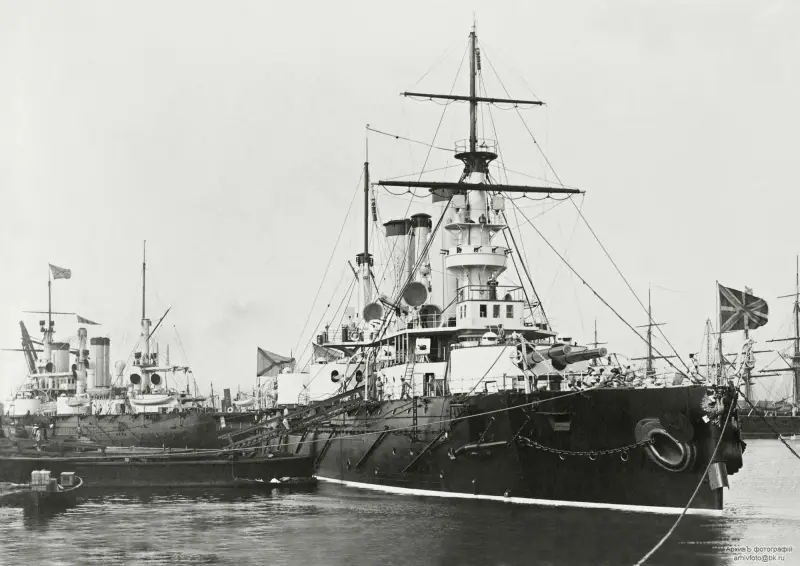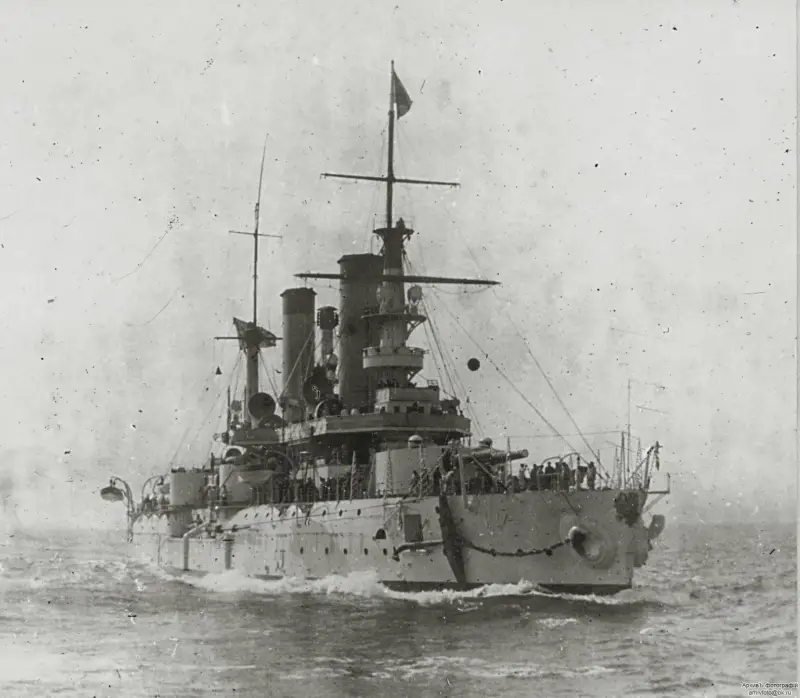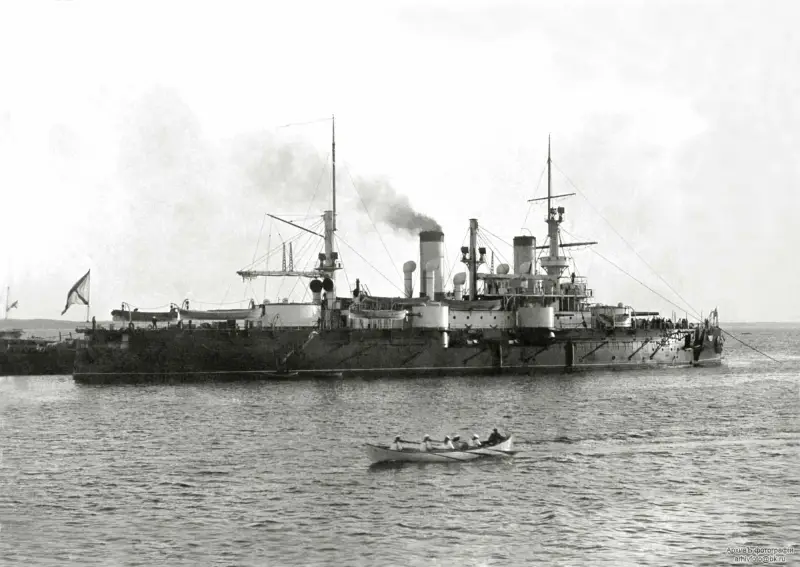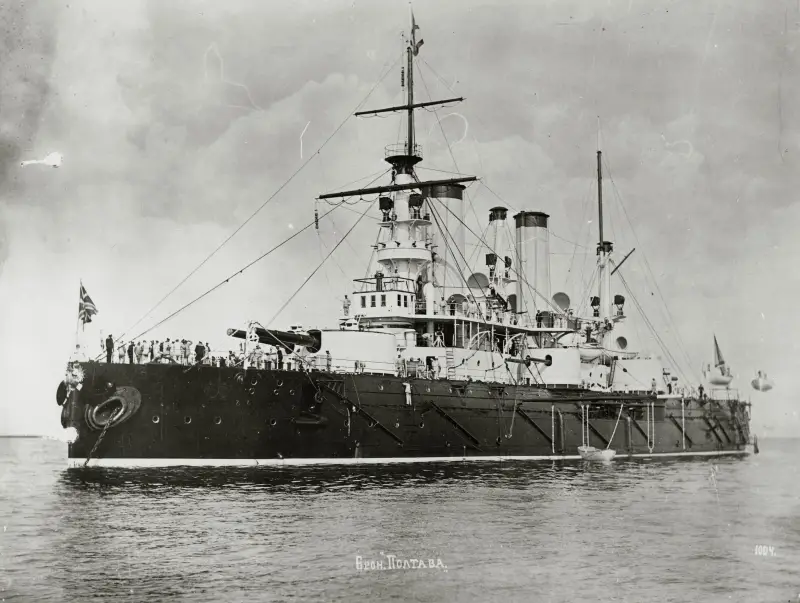The first tests of cemented armor in the Russian Empire and the protection of squadron battleships of the Poltava type

В previous article I presented to the respected reader test data on large-caliber projectiles equipped with Makarov tips, and some conclusions about domestically produced Krupp armor. Well, it's time to return to Harvey's armor.
About different types of armor
It is well known that in the second half of the 19th century, the protection of warships progressed at an extremely high speed for those years. It all started with iron armor, but soon it was replaced by steel-iron armor, the fundamental difference of which is directly implied by the name. Steel-iron was followed by steel and steel-nickel, and then the era of cemented armor arrived.
As you know, armor can be relatively soft, but at the same time tough: using certain hardening methods you can give it greater strength, but at the same time it becomes more fragile. The essence of cemented armor was that only the surface layer of the armor plate facing the projectile was hardened, followed by a viscous layer: that is why cemented armor was also called surface-hardened. Moreover, in the 127th and early XNUMXth centuries, only armor with a thickness of XNUMX mm and higher could be cemented; armor plates of smaller thickness were learned to be cemented later.
There were several methods for cementing armor, the most famous of them being the Harvey and Krupp methods, but there were others that were not widely used and therefore little known. Harvey's armor was first tested on November 14, 1891 and almost immediately replaced uncemented armor plates. But in 1893 the German weapons The Krupp plant developed an even more advanced technology for the production of armor, which is why the age of “Harvey” plates was short-lived. Soon all the world's fleets switched to Krupp armor, which for a long time became the standard for the quality of protection of warships.
Armored leapfrog
Let us remember how the most modern battleships that participated in the Russo-Japanese War defended themselves.
The main armor belts of "Petropavlovsk", "Sevastopol" and "Poltava" were formed from steel-nickel, "Harvey" and "crushed" armor plates, respectively, the sides of "Peresvet" and "Oslyabi" carried Harvey's armor. "Pobeda", "Retvizan", "Tsesarevich" and battleships of the "Borodino" type were protected by Krupp armor. As for their Japanese counterparts, of the six Japanese battleships that formed the basis of the United fleet, five carried armor cemented using the Harvey method and only “Mikasa” - Krupp.
Therefore, if an amateur stories If he wants to compare the security of the above-mentioned battleships, he will need to understand how the durability of the above types of armor compares. Take, for example, the armor of Krupp and Harvey - at first glance there is nothing complicated about it. Thus, according to the respected S. Balakin (“Triumphs of Tsushima”), the resistance of the Mikasa’s armor was 16–20% higher than that of its predecessor battleships. Such an assessment by a respected author correlates well with other publicly available data on the relationship between the durability of Krupp and Harvey armor.
But what do you want to do with other estimates made both upward and downward?
For example, in American publications (an article by Cleland Davis in the United States Naval Institute magazine for 1897), based on tests, it is indicated that the quality of the American-made garvey plate from the Carnegie plant turned out to be as good as that of the Krupp armor plate. And vice versa, Stepan Osipovich Makarov in his work “Battleships or armorless ships” indicates that Harvey’s armor with a thickness of 8,2 dm and 13,5 dm inches corresponds only to 6-dm and 10-dm Krupp armor, that is, the difference in durability is - 35–36,7%.
Even more interesting data is provided by N. L. Klado in the article “Artillery and Armor,” published in the work “Military Fleets and Naval Reference Book for 1906.” According to N. L. Klado, the durability of Krupp armor is 41,3% higher than Harvey’s!
Well, let's try to make sense of all this.
First domestic experiments
It must be said that in Russia they quite timely tracked both the displacement of the good old iron and steel-iron armor plates by steel-nickel and steel, and the appearance of “surface-hardened” armor. As mentioned above, the first tests of Harvey's armor took place at the end of 1891, and a year later, in November-December 1892, firing tests of the armor of the Ch. Kammel", "J. Brown", "Saint-Chamond" and "Vickers". At the same time, “Ch. Cammel" and "Saint-Chamon" presented "only a further development of the direction in which the plates had been improved before," but two other companies brought cemented armor to the competition. "J. Brown proposed cementation using the Tresider method, while Vickers proposed cementation using the Harvey method.
All armor plates were 10 inches thick, and the test consisted of firing them with 152-mm shells from the Putilov plant. Plates "Ch. Kammel" and "J. Brown" collapsed during testing, but "Saint-Chamon" (steel-nickel) and "Vickers" (Harvey) did not. Both slabs were not pierced and did not have through cracks, but the Vickers slab, thanks to cementation, turned out to be almost undamaged in comparison with Saint-Chamon. Then two more shots were fired at the Vickers, this time from a 229-mm gun: here the plate had already cracked through, but the shells also broke.
From “Appendix I to the MTK Artillery Report for 1895” it is known that the Vickers plate was fired with 152-mm shells weighing 95 pounds, that is, 38,9 kg, with a speed on the armor of 2 ft/sec (180 m/sec). There was no deviation from the normal; they fired so that the trajectory of the projectile passed strictly perpendicular to the surface of the slab. As I said earlier, this was the norm for testing armor plates in Russia in the 19th and early 20th centuries.
If the slab had been penetrated at the limit by a six-inch shell, then, according to de Marre's formula, its resistance coefficient "K" would have been 1. But this coefficient was probably much higher, since the slab received almost no damage. The 577 mm rounds were fired at an armor velocity of 229 ft/sec (1 m/sec) and weighed 655 lb or 504,5 kg.
The reference books indicate a slightly higher weight of shells for this weapon, namely 188,4 kg, but this is the weight of fully loaded ammunition, equipped with an explosive and a fuse. And when testing armor in those years, they fired unloaded shells, which, obviously, were not brought to the standard weight. For those years, this was a completely normal practice; this was done both here and, as will be seen later, abroad.
Recalculation according to de Marr shows that if 229 mm shells had penetrated the armor, then “K” would have been equal to 1, but they did not penetrate the armor. It can be said that the slab from the Vickers plant had an even greater “K” than 901, but it should be borne in mind that the responsible MTC officials considered that: “a 1-inch projectile ... although it is delayed, it causes such serious damage to the slab that it can no longer be considered a sufficiently reliable cover for the side.”
Thus, at least with certain stretches, we can assume that the Vickers armor plate had “K” = 1 without the condition of the projectile passing through the armor as a whole.
According to the test results, the Vickers armor, of course, won. But... which one?
Harvey – or “Harvey-Nickel”?
I have come across a lot of speculation on this topic on the Internet, but the question is, in fact, far from idle. The fact is that the addition of nickel significantly improved the durability of the armor. For example, according to S. O. Makarov, it turned out that the steel-nickel plate was stronger than ordinary steel, depending on the thickness of the armor plates being compared, by 7,8–8,6%. At the same time, both steel with and without a nickel additive could be subjected to carburization using the Harvey method; of course, with the same thickness, the latter would be less resistant.
What kind of armor was presented by Vickers?
V.I. Kolchak (the father of that same Kolchak), in his work “The History of the Obukhov Steel Plant in Connection with the Progress of Artillery Technology,” describing the tests of 1892, directly states: “Nickel was introduced into the steel of all plates, and in some, in addition , and chrome,” that is, in relation to the Vickers plate we are talking about “Harvey-nickel” armor.
Testing the protection of Poltava-class battleships
The protection of these ships is unique for a number of reasons.
Firstly, as mentioned above, each of them received belt armor that was different from the other two battleships. The sides of the Petropavlovsk were protected by steel-nickel armor, the Sevastopol received garvey plates, and the luckiest of all was the Poltava, which received a Krupp armor belt.
Secondly, all the waist armor of these ships was ordered abroad. For Petropavlovsk and Sevastopol, 605 tons and 550 tons, respectively, were purchased from Bethlehem Iron Company (USA), and Poltava received 764 tons of armor from the Krupp plant. Of course, these supplies did not cover the full needs of battleships, which ranged from 2 tons to 800 tons, including uncemented - deck, etc.
According to the calculations of the respected S.V. Suliga, the Krupp armor of the Poltava was enough for the armor belt, the walls of the towers and barbettes of the main battery, while the rest of the armor was provided by the Izhora and Obukhov factories, which had mastered the production of steel-nickel armor. It is quite obvious that the Russian armor industry did not have sufficient productivity to fully supply the same “Petropavlovsk” with its products.
Thus, the armor of the Poltava-class battleships was a “hodgepodge”, when part of the armor was completed with foreign supplies, and part was produced independently.
And here another interesting question arises.
It is known that Russian armor less than 127 mm for battleships of the Poltava type could not be cemented - they did not yet know how to produce it. But were domestic armor plates with a thickness of over 127 mm, which were supplied by Russian factories in varying quantities, cemented for all three ships of this series?
There are different opinions on this issue.
As S.V. Suliga writes, “almost all reference publications of that time indicate that these battleships had Harvey armor (sometimes the clarification follows - “mostly”),” but the respected historian himself believes that it was not Harvey armor that was supplied, but steel-nickel slabs
I have not found a source that would directly indicate that the Sevastopol-class battleships received domestic steel-nickel armor, but indirect data fully confirms this conclusion of S.V. Suliga. The fact is that initially armor for the fleet was made by the Izhora plant, also called Kolpinsky, because it was located in Kolpino, at the mouth of the Izhora River, but its capacity did not at all correspond to the pace of fleet construction.
And then the “armor revolution” arrived just in time with the transition from iron and steel to more advanced types of armor. Then it was decided to build a new production facility at the Obukhov plant and organize the production of thick slabs of vertical protection for ships, that is, the most complex type of armor. Other protection (armored deck, bevels, etc.) continued to be produced by the Izhora plant, since it had mastered this production well and coped with it.
But the production cycle of surface-hardened armor required special cementation furnaces, in which the plates were hardened for 15 to 20 days, not counting subsequent firing. It is quite obvious that a lot of such stoves were required, but they, according to the respected S. E. Vinogradov, were built only by 1896. Accordingly, it should be assumed that until this time the Obukhov plant could only produce single copies of cemented armor.
"Petropavlovsk" - steelnickel

Tests of the American 406-mm armor "Petropavlovsk" took place on July 1, 1895. The armor plate was installed on a wooden frame, after which they fired armor-piercing shells at it from a 229 mm/30 gun (as in Suliga, but most likely we are talking about a 229 mm/35 gun model 1877). In this case, the trajectory of the projectile was perpendicular to the plate, so there was no deviation from the normal. Several shots were fired, and the speed of the projectile gradually increased until the projectile pierced the armor, getting stuck in the frame, which was considered the limit of resistance of the armor plate. The shells were not equipped with armor-piercing tips.
The steel-nickel plate was pierced by the third shot - a 229-mm projectile, which, according to S.V. Suliga, weighed 179 kg.
Here lies a difficult to explain error.
The fact is that a respected historian writes verbatim: “the weight of the projectile is 446,25 Russian pounds, i.e. 179 kg,” while a Russian pound is 0,409512 kg, and 446,25 Russian pounds are equal to 182,7 kg.
The attentive reader, undoubtedly, noticed that the Vickers plate, according to “Addendum I to the MTK report on artillery for 1895,” was fired with a lighter projectile, weighing 181,4 kg. But a deviation of 1,3 kg is quite normal: as you know, the actual weight of a projectile of one design is not a constant and may deviate slightly from the standard. But during armor testing, the actual weight was recorded, that is, each shell was weighed before use.
So, a 229-mm 182,7-kg projectile penetrated a 406-mm plate at a projectile speed of 531 m/sec, which, according to testers, corresponded to the resistance of 546-mm iron armor. Consequently, steel-nickel turned out to be 1,345 times stronger than iron. Having recalculated the result using the formula of Jacob de Marre, we obtain the coefficient “K” = 1. Since from the explanations of S.V. Suliga it turns out that the projectile got stuck in the frame after breaking through the armor, this “K” apparently corresponds to the “gray” a zone in which the probabilities of a projectile passing through the armor as a whole or in broken form are close.
"Sevastopol" - Harvey

A steel-nickel (according to S.V. Suliga) slab with a thickness of 368 mm, cemented using the Harvey method, was tested on November 23, 1895. 6 shots were fired at it: three 229 mm and the same number of 152 mm, the latter being fired from the newest Kane cannon. At the same time, the six-inch gun fired with a deviation from the normal of 5 degrees. Not a single shell penetrated the armor, so to determine the resistance, a 229-mm shell was fired, which had a weight (according to S.V. Suliga) of 178 kg at a speed of 588 m/sec, which penetrated the deepest into the plate. Adjusting for the error described above, we should expect that the weight of the projectile was 181,7 kg.
Since “clean penetration” did not take place, the resistance of the plate was determined by calculation, equating the resistance of 368 mm Harvey armor to 635 mm iron. In other words, the harvey armor of the battleship “Sevastopol” turned out to be 1,726 times stronger than the iron armor and 1,283 times better than the steel-nickel armor of the “Petropavlovsk”. In this case, recalculation using the de Marre formula will give “K” = 1.
Noteworthy is the fact that substituting into the de Marre formula the values of armor thickness/projectile weight/velocity on 368 mm armor; 181,7 kg and 588 m/sec, respectively, give a very close value (K = 1), that is, according to testers, the projectile was literally “a hair's breadth” from breaking through the armor, it almost pierced it. Of course, the resulting value “K” = 710 corresponds to a projectile that crashed against the armor rather than passing through it as a whole.
"Poltava" - Krupp

Now let’s look at the results of firing at Krupp’s armor, which was used to defend the Poltava.
There are also some contradictions here, however, easily resolved.
From the “Report” on the tests referred to by S.V. Suliga, it turns out that on October 28, 1896, they fired at a 254-mm plate from a 203-mm gun, but which one exactly (the old 35-caliber or the new 45-caliber) - not said. At the same time, the document states that the projectile weighed 48,12 kg, but this is an obvious mistake, which was pointed out by S.V. Suliga: there was no ammunition of this weight for eight-inch artillery systems in Russia. The speed upon impact with the slab was 758 m/sec.
In "Appendix I to the MTK Artillery Report for 1895" (published later than this date, so it is not surprising that it mentions the tests of 1896) states that a 10-mm projectile weighing 203 Russian pounds was fired at a 210,25-inch Krupp plate, which would be 86,1 kg. Unfortunately, it does not directly indicate that we are talking about testing armor for Poltava, but, on the other hand, the similarity of the parameters and testing time speaks for itself.
The shell broke, but pierced the plate: “K”, according to de Marr, amounted to 2, which, in general, is slightly below the limit of the standard resistance of domestically produced Krupp armor for 155-mm shells (“K” 203–2), but the deviation is negligible.
"Poltava" - Russian steel nickel
V.I. Kolchak describes the tests of the 10-inch thick armor plate of the Obukhov plant, manufactured for the battleship Poltava. As mentioned above, although direct evidence of this was not found, this slab, according to S.V. Suliga, was uncemented steel-nickel. It was hit by 5 shots of 152 mm shells weighing 97 pounds (39,73 kg) with a speed on the armor of 2 feet or 140 meters per second. The maximum that the shells could penetrate was 652,3 inches into the slab. If the shells had penetrated the armor to the limit, then its “K” would have been equal to 8, but it is obvious that it turned out to be significantly higher.
Assuming that 203 mm is the maximum armor penetration with such projectile parameters, we get “K” = 1. Most likely, the real durability of a domestically produced steel-nickel plate was in the range of these values.
But then it turns out that it turned out to be not only stronger than the American steel-nickel plate, but was also close in durability to the US garvey plate.
It is also worth noting the good quality of Russian steel shells - not having the power to penetrate the armor plate, they bounced off it as a whole, without breaking or even having cracks.
Conclusions
There will be almost none for now.
Let us note that, for unknown reasons, the Naval Ministry accepted into the treasury the garvey armor of the American Bethlehem Iron Company, which was inferior to the previously tested Vickers, and the steel-nickel armor of the same company, which was inferior to similar armor made domestically.
There could be several reasons for this.
I have already demonstrated earlierthat the durability of the domestic Krupp armor was not constant and varied over significant ranges. So, for example, if the standard values of “K” for 12-dm shells for Krupp armor of the same thickness were 2–100, then other armor plates could reach “K” = 2, which corresponded to an increase in durability by 200% (I remind you that the durability of the slab does not increase in direct proportion to the “K” coefficient). Accordingly, it should be expected that similar vibrations are also characteristic of other types of armor, including Harvey.
Therefore, it can be assumed that the production processes of the USA, England and Russia for the production of steel-nickel and Harvey armor were similar, but the cards fell so that the products of Vickers and Obukhov plant showed the best (or close to them) values, and Bethlehem Iron Company » – minimal. But it is still extremely strange that American products turned out to be an outsider in relation to both English and Russian armor - this suggests that the quality of the Bethlehem Iron Company armor was still not up to par.
In any case, we have to state the fact that the domestic battleships Sevastopol and Petropavlovsk received armored belts that were far from being of the best possible quality. But it is too early to draw any far-reaching conclusions about the comparative strength of armor based on all of the above.
Продолжение следует ...
Information